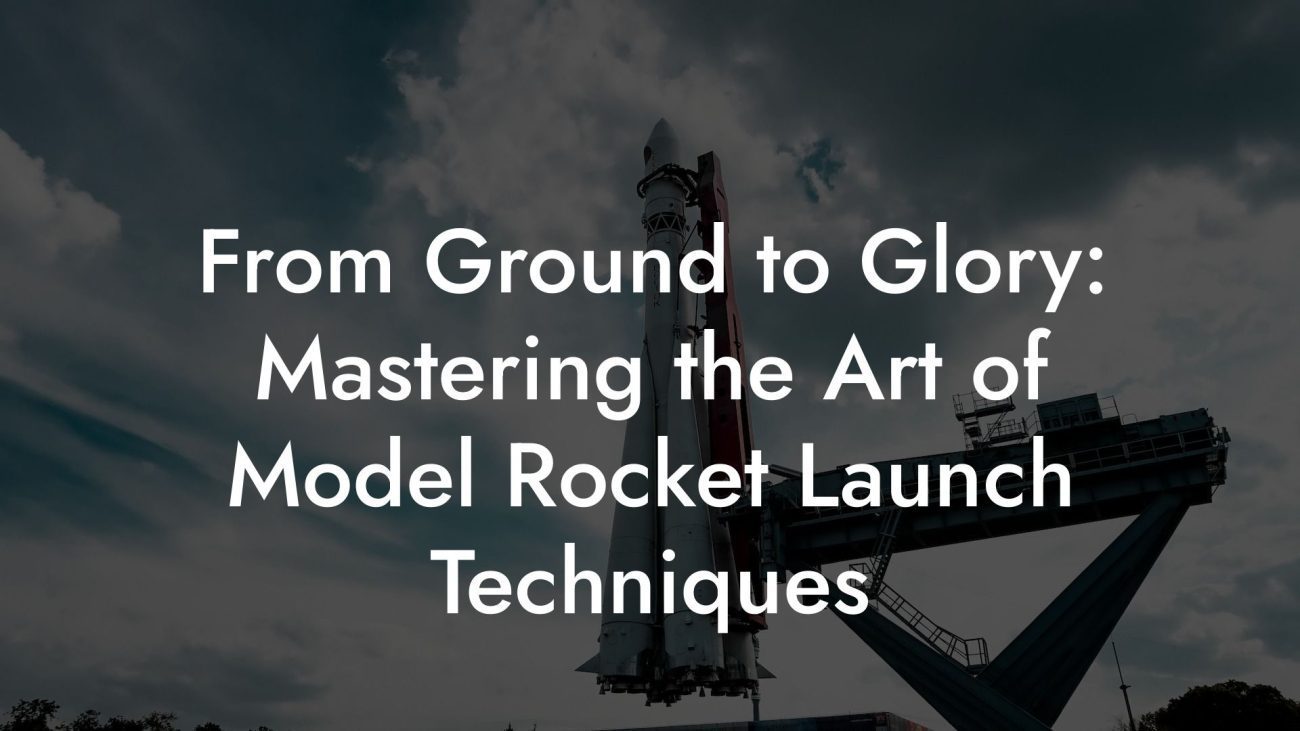After every liftoff, your rocket’s journey continues well beyond the dazzling burst of flame and ascent into the sky. "Post-Launch Analysis: Learning from Your Rocket's Flight Patterns" is your in-depth guide to understanding the data and observations collected after each flight. By analyzing flight patterns, you can identify performance trends, troubleshoot issues, and refine your design for future launches, turning every flight into an opportunity for improvement.
Quick Links to Useful Sections
- Introduction: The Value of Post-Launch Analysis
- Collecting and Organizing Flight Data
- Key Data Points
- Analyzing Flight Patterns: What the Data Tells You
- Interpreting Altitude and Trajectory
- Velocity and Acceleration Analysis
- Identifying Anomalies
- Tools and Techniques for Effective Analysis
- Data Loggers and Onboard Sensors
- High-Speed Video Analysis
- Software for Data Visualization
- Case Studies: Learning from Real-World Flights
- The Smooth Ascent
- The Unexpected Dip
- The Data-Driven Optimizer
- Iterative Improvement: Applying Lessons Learned
- Model Rocket Post-Launch Analysis FAQs
- Your Next Launch: Learn, Adapt, and Soar Higher
Introduction: The Value of Post-Launch Analysis
Every model rocket launch is a learning experience. Post-launch analysis involves reviewing flight data, observing flight behavior, and comparing performance against your expectations. This process not only helps you understand what worked well but also reveals areas for improvement. By scrutinizing your rocket's flight patterns, from its initial trajectory to its recovery, you gain valuable insights that can inform design tweaks, fuel adjustments, and stability enhancements.
In this guide, we’ll explore the tools and techniques for effective post-launch analysis, explain how to interpret key flight data, and provide practical tips for transforming your observations into actionable improvements.
Collecting and Organizing Flight Data
The first step in post-launch analysis is gathering all available flight data. This data may come from onboard sensors, high-speed video recordings, and manual observations recorded during the flight.
Key Data Points
- Altitude: Peak altitude and the flight profile during ascent.
- Velocity and Acceleration: How quickly your rocket gains speed and how it decelerates during recovery.
- Trajectory: The flight path, including any deviations from a straight line.
- Engine Burn Characteristics: Thrust, burn duration, and any anomalies in engine performance.
Organizing this data into graphs and charts makes it easier to spot trends and irregularities. Digital tools and software, such as data loggers and analysis programs, can help you visualize your flight profile effectively.
Looking For The Best Model Rocket Kits? You'll Love These:
Analyzing Flight Patterns: What the Data Tells You
Once you’ve collected your data, it’s time to analyze it. Look for patterns that reveal both strengths and weaknesses in your rocket’s performance.
Interpreting Altitude and Trajectory
Examine the altitude curve of your flight. A smooth, gradual climb to a peak altitude followed by a controlled descent indicates optimal performance. Deviations, such as sudden drops or unexpected fluctuations, may suggest issues with engine burn or aerodynamic instability.
Velocity and Acceleration Analysis
Analyze your velocity and acceleration graphs to understand the thrust efficiency of your engine. Sudden spikes or dips can indicate inconsistencies in the fuel burn or potential misalignments in the rocket’s structure.
Identifying Anomalies
Look for anomalies such as irregular flight paths or premature recovery activation. These signs can point to problems with engine performance, recovery system deployment, or even weather-related disturbances during the flight.
Tools and Techniques for Effective Analysis
Modern technology offers a range of tools to help you analyze flight data with precision:
Data Loggers and Onboard Sensors
Onboard data loggers capture real-time flight parameters that you can later download and analyze. Sensors such as accelerometers, altimeters, and gyroscopes provide detailed insights into the rocket’s performance.
High-Speed Video Analysis
Recording your launch with a high-speed camera allows you to visually inspect the rocket’s flight. Slow-motion playback can reveal subtle deviations in trajectory or issues during recovery deployment.
Software for Data Visualization
Utilize software like MATLAB, Excel, or specialized rocketry analysis programs to convert raw data into graphs and charts. These visual tools make it easier to spot trends and outliers.
By combining these tools, you can build a comprehensive picture of your rocket's performance and pinpoint specific areas for improvement.
Case Studies: Learning from Real-World Flights
Real-world examples illustrate the power of post-launch analysis:
The Smooth Ascent
One rocketeer noted that their altitude data closely matched the predicted trajectory, indicating that the engine burn was consistent. However, minor deviations in the recovery phase led to adjustments in the parachute packing technique, resulting in a smoother landing in subsequent flights.
The Unexpected Dip
In another case, a sudden drop in acceleration during ascent revealed a potential misalignment in the engine mount. After realigning the engine and rebalancing the rocket, the next flight showed a significant improvement in performance.
The Data-Driven Optimizer
A team used telemetry data to fine-tune their fuel mixture, extending burn time and increasing overall impulse. Their iterative testing and detailed analysis led to a rocket that achieved higher altitudes and more consistent recovery.
These examples highlight how careful analysis of flight data can drive meaningful improvements in design and performance.
Iterative Improvement: Applying Lessons Learned
The true power of post-launch analysis lies in its ability to inform your next steps. Use the insights gained from each flight to:
- Adjust engine alignment and fuel composition
- Refine aerodynamic surfaces and fin configurations
- Improve the deployment timing of your recovery system
- Modify the overall balance and structural integrity of your rocket
By embracing an iterative approach, each launch becomes a stepping stone towards greater performance and reliability.
Model Rocket Post-Launch Analysis FAQs
Here are some frequently asked questions to help you get the most out of your flight data analysis:
1. Why is post-launch analysis important?
It helps you understand the performance of your rocket, identify issues, and make data-driven improvements for future launches.
2. What key data points should I focus on?
Focus on altitude, velocity, acceleration, engine burn time, and the stability of your flight trajectory.
3. How can I visualize flight data effectively?
Use software tools to create graphs and charts that plot altitude, velocity, and acceleration over time, making trends and anomalies easier to identify.
4. What should I do if my flight data shows unexpected anomalies?
Investigate potential causes such as engine misalignment, fuel inconsistencies, or aerodynamic issues, and adjust your design accordingly.
5. How can telemetry improve my analysis?
Telemetry provides real-time data on your rocket’s performance, allowing for precise measurement and immediate feedback that can guide your improvements.
6. What role does high-speed video play in analysis?
High-speed video captures detailed visuals of the flight, helping you identify subtle issues with trajectory or recovery that may not be evident from numerical data alone.
7. How often should I review and update my design based on flight data?
After each launch, review your data and update your design as necessary. Continuous improvement is key to long-term success in model rocketry.
8. Can I use post-launch data to improve engine performance?
Yes, analyzing thrust curves and burn time can reveal performance issues that allow you to optimize engine alignment and fuel formulations.
9. Is it necessary to use specialized software for analysis?
While specialized software can greatly enhance data visualization, even basic tools like spreadsheets can be effective for initial analysis.
10. What common mistakes should I avoid during post-launch analysis?
Avoid relying solely on raw data without visual aids, and ensure that sensor calibration is performed correctly to prevent inaccurate readings.
Your Next Launch: Learn, Adapt, and Soar Higher
Post-launch analysis transforms every flight into a learning opportunity. By meticulously reviewing your rocket’s performance, you can uncover valuable insights that drive continuous improvements and innovative design tweaks.
Embrace the data, refine your techniques, and let every launch propel you closer to perfection. With each flight, you’re not just reaching for the sky, you’re learning to master it.
Analyze, adapt, and then launch again, because the journey to higher altitudes is paved with lessons learned and innovations applied.
Looking For The Best Model Rocket Kits? You'll Love These:
Useful Interruption: Dive deeper into the world of Model Rockets with our most popular sections. If there is anything you think is missing or anything you would love for us to write about, just give us a shout.
- Getting Started & Basics With Model Rockets
- Model Rocket Design, Build & Customization
- Model Rocket Propulsion & Engine Technology
- Model Rocket Launch Techniques & Recovery
- Model Rocket Advanced Rocketry & Innovations
- Model Rocket DIY and Customization
- Model Rocket Equipment Reviews & Digital Tools
- Community, Competitions & Education
- Model Rocket Troubleshooting & FAQs
- Model Rocket Bonus/Seasonal & Niche Topics
A group of model rocket enthusiasts gathered at a field for their weekly launch event. Among them was Dave, a seasoned builder known for pushing the limits of hobby rocketry. This time, he had outdone himself.
“Ladies and gentlemen,” Dave announced, dramatically pulling a cloth off his latest creation, “I present to you: The Kraken!”
The crowd gasped. This wasn’t just a model rocket, it was a monster. The thing stood 8 feet tall, had six clustered engines, and was covered in enough duct tape to qualify as a classified aerospace project.
“Dave,” muttered Steve, the cautious safety officer, “Have you, uh… done the math on this?”
“Math?” Dave scoffed. “I built it in my garage at 3 a.m. with parts from eBay. This is an art piece, Steve.”
The countdown began.
5…
4…
3…
2…
1…
The engines ignited with a BOOM, and The Kraken shot up… kind of. It immediately did a violent barrel roll, narrowly missing the spectators before skyrocketing at an angle that could only be described as “legally questionable.”
The crowd collectively ducked as The Kraken flew straight over the adjacent cornfield, where Old Man Jenkins, the grumpiest farmer in town, was minding his business.
KABOOM!
The rocket disappeared behind the barn. A moment later, a flaming piece of Estes igniter wire landed at Steve’s feet. The silence was deafening.
And then, an unmistakable sound echoed across the field.
Jenkins’ shotgun being cocked.
“DAVE!!!” Steve shouted. “RUN.”
And that was the day Dave invented the first-ever biologically powered rocket booster: pure adrenaline.
To this day, nobody knows where The Kraken landed, but legend has it, it still haunts the skies, terrifying unsuspecting drones and low-flying birds.










